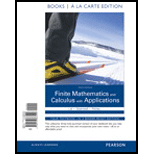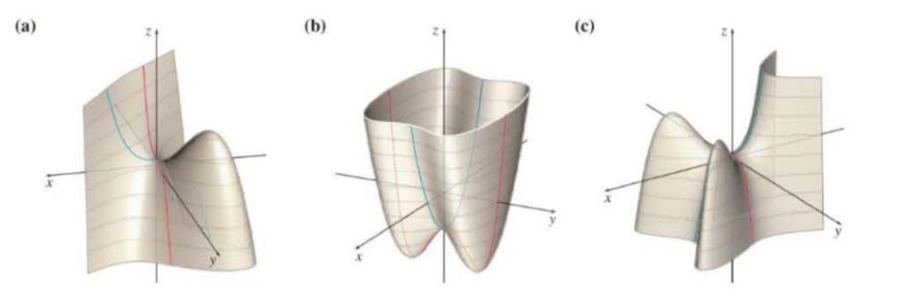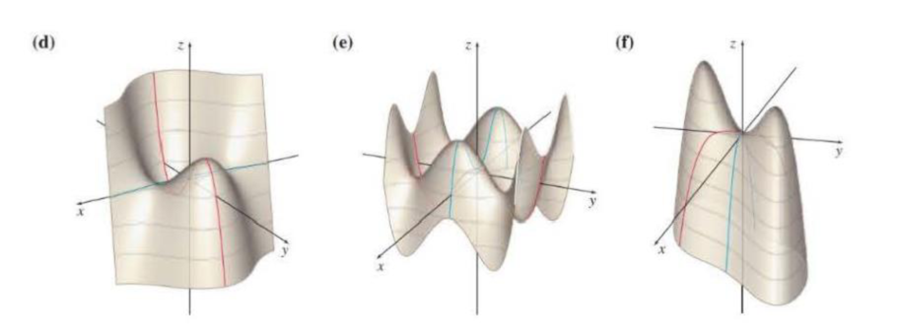
Finite Mathematics and Calculus with Applications Books a la Carte Plus MyLab Math Package (10th Edition)
10th Edition
ISBN: 9780133935592
Author: Margaret L. Lial, Raymond N. Greenwell, Nathan P. Ritchey
Publisher: PEARSON
expand_more
expand_more
format_list_bulleted
Concept explainers
Textbook Question
Chapter 17.3, Problem 24E
Figures (a)–(f) show the graphs of the functions defined in Exercises 21–26. Find all relative extrema for each function, and then match the equation to its graph.
24.


Expert Solution & Answer
Want to see the full answer?
Check out a sample textbook solution
Students have asked these similar questions
Find a plane containing the point (3, -3, 1) and the line of intersection of the planes 2x + 3y - 3z = 14
and -3x - y + z = −21.
The equation of the plane is:
Determine whether the lines
L₁ : F(t) = (−2, 3, −1)t + (0,2,-3) and
L2 : ƒ(s) = (2, −3, 1)s + (−10, 17, -8)
intersect. If they do, find the point of intersection.
● They intersect at the point
They are skew lines
They are parallel or equal
Answer questions 2
Chapter 17 Solutions
Finite Mathematics and Calculus with Applications Books a la Carte Plus MyLab Math Package (10th Edition)
Ch. 17.1 - For the function in Example 1, find f(2, 3)....Ch. 17.1 - Prob. 2YTCh. 17.1 - Prob. 3YTCh. 17.1 - Prob. 4YTCh. 17.1 - Prob. 1WECh. 17.1 - Prob. 2WECh. 17.1 - Prob. 3WECh. 17.1 - Prob. 4WECh. 17.1 - Prob. 5WECh. 17.1 - Prob. 6WE
Ch. 17.1 - Let f(x, y) = 2x 3y + 5. Find the following....Ch. 17.1 - Prob. 2ECh. 17.1 - Prob. 3ECh. 17.1 - Prob. 4ECh. 17.1 - Prob. 5ECh. 17.1 - Prob. 6ECh. 17.1 - Prob. 7ECh. 17.1 - Prob. 8ECh. 17.1 - Graph the first-octant portion of each plane. 9.2x...Ch. 17.1 - Prob. 10ECh. 17.1 - Prob. 11ECh. 17.1 - Prob. 12ECh. 17.1 - Prob. 13ECh. 17.1 - Prob. 14ECh. 17.1 - Prob. 15ECh. 17.1 - Prob. 16ECh. 17.1 - Prob. 17ECh. 17.1 - Prob. 18ECh. 17.1 - Prob. 19ECh. 17.1 - Prob. 20ECh. 17.1 - Prob. 21ECh. 17.1 - Prob. 22ECh. 17.1 - Match each equation in Exercises 2328 with its...Ch. 17.1 - Prob. 24ECh. 17.1 - Prob. 25ECh. 17.1 - Match each equation in Exercises 2328 with its...Ch. 17.1 - Prob. 27ECh. 17.1 - Prob. 28ECh. 17.1 - Prob. 29ECh. 17.1 - Prob. 30ECh. 17.1 - Prob. 31ECh. 17.1 - Prob. 32ECh. 17.1 - Prob. 33ECh. 17.1 - Prob. 34ECh. 17.1 - Production Find the level curve at a production of...Ch. 17.1 - Prob. 36ECh. 17.1 - Prob. 37ECh. 17.1 - Individual Retirement Accounts The multiplier...Ch. 17.1 - Individual Retirement Accounts The multiplier...Ch. 17.1 - Heat Loss The rate of heal loss (in watts) in...Ch. 17.1 - Prob. 41ECh. 17.1 - Prob. 42ECh. 17.1 - Pollution Intolerance According to research at the...Ch. 17.1 - Dengue Fever In tropical regions, dengue fever is...Ch. 17.1 - Prob. 45ECh. 17.1 - Prob. 46ECh. 17.1 - Prob. 47ECh. 17.1 - Prob. 48ECh. 17.1 - Prob. 49ECh. 17.1 - Prob. 50ECh. 17.1 - Prob. 51ECh. 17.2 - Prob. 1YTCh. 17.2 - Prob. 2YTCh. 17.2 - Prob. 3YTCh. 17.2 - Prob. 4YTCh. 17.2 - Prob. 1WECh. 17.2 - Prob. 2WECh. 17.2 - Prob. 3WECh. 17.2 - Prob. 4WECh. 17.2 - Prob. 5WECh. 17.2 - Prob. 6WECh. 17.2 - Prob. 7WECh. 17.2 - Prob. 8WECh. 17.2 - Prob. 1ECh. 17.2 - Prob. 2ECh. 17.2 - Prob. 3ECh. 17.2 - Prob. 4ECh. 17.2 - Prob. 5ECh. 17.2 - Prob. 6ECh. 17.2 - Prob. 7ECh. 17.2 - Prob. 8ECh. 17.2 - Prob. 9ECh. 17.2 - Prob. 10ECh. 17.2 - Prob. 11ECh. 17.2 - Prob. 12ECh. 17.2 - Prob. 13ECh. 17.2 - Prob. 14ECh. 17.2 - Prob. 15ECh. 17.2 - Prob. 16ECh. 17.2 - Prob. 17ECh. 17.2 - Prob. 18ECh. 17.2 - Prob. 19ECh. 17.2 - Prob. 20ECh. 17.2 - Prob. 21ECh. 17.2 - Prob. 22ECh. 17.2 - Prob. 23ECh. 17.2 - Prob. 24ECh. 17.2 - Prob. 25ECh. 17.2 - Prob. 26ECh. 17.2 - Prob. 27ECh. 17.2 - Prob. 28ECh. 17.2 - Prob. 29ECh. 17.2 - Prob. 30ECh. 17.2 - Prob. 31ECh. 17.2 - Prob. 32ECh. 17.2 - Prob. 33ECh. 17.2 - Prob. 34ECh. 17.2 - Prob. 35ECh. 17.2 - Prob. 36ECh. 17.2 - Prob. 37ECh. 17.2 - Prob. 38ECh. 17.2 - Prob. 39ECh. 17.2 - Prob. 40ECh. 17.2 - Find fx(x,y,z),fy(x,y,z),fz(x,y,z), and fyz(x,y,z)...Ch. 17.2 - Prob. 42ECh. 17.2 - Prob. 43ECh. 17.2 - Prob. 44ECh. 17.2 - Business and Economics 45.Manufacturing Cost...Ch. 17.2 - Prob. 46ECh. 17.2 - Prob. 47ECh. 17.2 - Prob. 48ECh. 17.2 - Prob. 49ECh. 17.2 - Prob. 50ECh. 17.2 - Prob. 51ECh. 17.2 - Prob. 52ECh. 17.2 - Prob. 53ECh. 17.2 - Prob. 54ECh. 17.2 - Prob. 55ECh. 17.2 - Prob. 56ECh. 17.2 - Prob. 57ECh. 17.2 - Prob. 58ECh. 17.2 - Prob. 59ECh. 17.2 - Prob. 60ECh. 17.2 - Prob. 61ECh. 17.2 - Prob. 62ECh. 17.2 - Drug Reaction The reaction to x units of a drug t...Ch. 17.2 - Prob. 64ECh. 17.2 - Prob. 66ECh. 17.2 - Prob. 67ECh. 17.2 - Prob. 68ECh. 17.2 - Gravitational Attraction The gravitational...Ch. 17.2 - Velocity In 1931, Albert Einstein developed the...Ch. 17.2 - Prob. 71ECh. 17.3 - Prob. 1YTCh. 17.3 - Prob. 2YTCh. 17.3 - Prob. 1WECh. 17.3 - Prob. 2WECh. 17.3 - Prob. 1ECh. 17.3 - Prob. 2ECh. 17.3 - Prob. 3ECh. 17.3 - Prob. 4ECh. 17.3 - Prob. 5ECh. 17.3 - Prob. 6ECh. 17.3 - Prob. 7ECh. 17.3 - Prob. 8ECh. 17.3 - Prob. 9ECh. 17.3 - Prob. 10ECh. 17.3 - Prob. 11ECh. 17.3 - Prob. 12ECh. 17.3 - Prob. 13ECh. 17.3 - Prob. 14ECh. 17.3 - Prob. 15ECh. 17.3 - Prob. 16ECh. 17.3 - Prob. 17ECh. 17.3 - Prob. 18ECh. 17.3 - Prob. 19ECh. 17.3 - Prob. 20ECh. 17.3 - Prob. 21ECh. 17.3 - Prob. 22ECh. 17.3 - Prob. 23ECh. 17.3 - Figures (a)(f) show the graphs of the functions...Ch. 17.3 - Prob. 25ECh. 17.3 - Prob. 26ECh. 17.3 - Prob. 27ECh. 17.3 - Prob. 28ECh. 17.3 - Prob. 29ECh. 17.3 - Prob. 30ECh. 17.3 - Prob. 31ECh. 17.3 - Prob. 32ECh. 17.3 - Prob. 33ECh. 17.3 - Prob. 34ECh. 17.3 - Prob. 35ECh. 17.3 - Prob. 36ECh. 17.3 - Prob. 37ECh. 17.3 - Prob. 38ECh. 17.3 - Prob. 39ECh. 17.3 - Prob. 40ECh. 17.3 - Prob. 42ECh. 17.4 - Prob. 1YTCh. 17.4 - Prob. 1WECh. 17.4 - Prob. 2WECh. 17.4 - Find the relative maxima or minima in Exercises...Ch. 17.4 - Find the relative maxima or minima in Exercises...Ch. 17.4 - Find the relative maxima or minima in Exercises...Ch. 17.4 - Find the relative maxima or minima in Exercises...Ch. 17.4 - Find the relative maxima or minima in Exercises...Ch. 17.4 - Find the relative maxima or minima in Exercises...Ch. 17.4 - Find the relative maxima or minima in Exercises...Ch. 17.4 - Find the relative maxima or minima in Exercises...Ch. 17.4 - Find the relative maxima or minima in Exercises...Ch. 17.4 - Find the relative maxima or minima in Exercises...Ch. 17.4 - Prob. 11ECh. 17.4 - Find positive numbers x and y such that x + y = 48...Ch. 17.4 - Prob. 13ECh. 17.4 - Prob. 14ECh. 17.4 - Find the maximum and minimum values of f(x, y) =x3...Ch. 17.4 - Prob. 16ECh. 17.4 - Prob. 17ECh. 17.4 - Prob. 18ECh. 17.4 - Prob. 19ECh. 17.4 - Prob. 20ECh. 17.4 - Prob. 21ECh. 17.4 - Discuss the advantages and disadvantages of the...Ch. 17.4 - Prob. 23ECh. 17.4 - Prob. 24ECh. 17.4 - Prob. 25ECh. 17.4 - Prob. 26ECh. 17.4 - Prob. 27ECh. 17.4 - Prob. 28ECh. 17.4 - Prob. 29ECh. 17.4 - Prob. 30ECh. 17.4 - Prob. 31ECh. 17.4 - Prob. 32ECh. 17.4 - Prob. 33ECh. 17.4 - Prob. 34ECh. 17.4 - Prob. 35ECh. 17.4 - Prob. 36ECh. 17.4 - Prob. 37ECh. 17.4 - Prob. 38ECh. 17.4 - Prob. 39ECh. 17.4 - Prob. 40ECh. 17.4 - Prob. 41ECh. 17.4 - Prob. 42ECh. 17.5 - Prob. 1YTCh. 17.5 - Prob. 2YTCh. 17.5 - Prob. 3YTCh. 17.5 - Prob. 1WECh. 17.5 - Prob. 2WECh. 17.5 - Prob. 3WECh. 17.5 - Prob. 4WECh. 17.5 - Prob. 1ECh. 17.5 - Prob. 2ECh. 17.5 - Prob. 3ECh. 17.5 - Prob. 4ECh. 17.5 - Prob. 5ECh. 17.5 - Prob. 6ECh. 17.5 - Prob. 7ECh. 17.5 - Prob. 8ECh. 17.5 - Prob. 9ECh. 17.5 - Prob. 10ECh. 17.5 - Prob. 11ECh. 17.5 - Prob. 12ECh. 17.5 - Prob. 13ECh. 17.5 - Prob. 14ECh. 17.5 - Prob. 15ECh. 17.5 - Prob. 16ECh. 17.5 - Volume of a Coating An industrial coaling 0.1 in....Ch. 17.5 - Prob. 18ECh. 17.5 - Prob. 19ECh. 17.5 - Prob. 20ECh. 17.5 - Prob. 21ECh. 17.5 - Prob. 22ECh. 17.5 - Prob. 23ECh. 17.5 - Prob. 24ECh. 17.5 - Life Span As we saw in Exercise 62 of Section...Ch. 17.5 - Prob. 26ECh. 17.5 - Prob. 27ECh. 17.5 - Prob. 28ECh. 17.5 - Prob. 29ECh. 17.5 - Prob. 30ECh. 17.5 - Prob. 31ECh. 17.5 - Prob. 32ECh. 17.5 - Prob. 33ECh. 17.5 - Prob. 34ECh. 17.5 - Prob. 35ECh. 17.6 - Prob. 1YTCh. 17.6 - Evaluate 02[13(6x2y2+4xy+8x3+10y4+3)dy]dx and then...Ch. 17.6 - Prob. 3YTCh. 17.6 - Prob. 4YTCh. 17.6 - Prob. 5YTCh. 17.6 - Prob. 1WECh. 17.6 - Evaluate each definite integral. W2.23x+6dxCh. 17.6 - Prob. 3WECh. 17.6 - Prob. 4WECh. 17.6 - Prob. 5WECh. 17.6 - Prob. 6WECh. 17.6 - Prob. 1ECh. 17.6 - Prob. 2ECh. 17.6 - Prob. 3ECh. 17.6 - Prob. 4ECh. 17.6 - Prob. 5ECh. 17.6 - Prob. 6ECh. 17.6 - Prob. 7ECh. 17.6 - Prob. 8ECh. 17.6 - Prob. 9ECh. 17.6 - Prob. 10ECh. 17.6 - Prob. 11ECh. 17.6 - Prob. 12ECh. 17.6 - Prob. 13ECh. 17.6 - Prob. 14ECh. 17.6 - Prob. 15ECh. 17.6 - Prob. 16ECh. 17.6 - Prob. 17ECh. 17.6 - Prob. 18ECh. 17.6 - Prob. 19ECh. 17.6 - Prob. 20ECh. 17.6 - Prob. 21ECh. 17.6 - Prob. 22ECh. 17.6 - Prob. 23ECh. 17.6 - Prob. 24ECh. 17.6 - Prob. 25ECh. 17.6 - Prob. 26ECh. 17.6 - Prob. 27ECh. 17.6 - Prob. 28ECh. 17.6 - Prob. 29ECh. 17.6 - Prob. 30ECh. 17.6 - Prob. 31ECh. 17.6 - Prob. 32ECh. 17.6 - Prob. 33ECh. 17.6 - Prob. 34ECh. 17.6 - Prob. 35ECh. 17.6 - Prob. 36ECh. 17.6 - Prob. 37ECh. 17.6 - Prob. 38ECh. 17.6 - Prob. 39ECh. 17.6 - Prob. 40ECh. 17.6 - Prob. 41ECh. 17.6 - Prob. 42ECh. 17.6 - Prob. 43ECh. 17.6 - Use the region R with the indicated boundaries to...Ch. 17.6 - Prob. 45ECh. 17.6 - Prob. 46ECh. 17.6 - Prob. 47ECh. 17.6 - Prob. 48ECh. 17.6 - Prob. 49ECh. 17.6 - Prob. 50ECh. 17.6 - Prob. 51ECh. 17.6 - Prob. 52ECh. 17.6 - Prob. 53ECh. 17.6 - Prob. 54ECh. 17.6 - Prob. 55ECh. 17.6 - Prob. 56ECh. 17.6 - Prob. 57ECh. 17.6 - Prob. 58ECh. 17.6 - Prob. 59ECh. 17.6 - Prob. 60ECh. 17.6 - Prob. 61ECh. 17.6 - Prob. 62ECh. 17.6 - Prob. 63ECh. 17.6 - Prob. 64ECh. 17.6 - Prob. 65ECh. 17.6 - Prob. 66ECh. 17.6 - Prob. 67ECh. 17.6 - Prob. 68ECh. 17.6 - Prob. 69ECh. 17.6 - Time In Exercise 39 of Section 17.3, we saw that...Ch. 17.6 - Profit In Exercise 38 of Section 17.3, we saw that...Ch. 17 - Determine whether each of the following statements...Ch. 17 - Prob. 2RECh. 17 - Prob. 3RECh. 17 - Prob. 4RECh. 17 - Prob. 5RECh. 17 - Prob. 6RECh. 17 - Prob. 7RECh. 17 - Prob. 8RECh. 17 - Prob. 9RECh. 17 - Prob. 10RECh. 17 - Prob. 11RECh. 17 - Prob. 12RECh. 17 - Prob. 13RECh. 17 - Prob. 14RECh. 17 - Prob. 15RECh. 17 - Prob. 16RECh. 17 - Prob. 17RECh. 17 - Prob. 18RECh. 17 - Prob. 19RECh. 17 - Prob. 20RECh. 17 - Prob. 21RECh. 17 - Prob. 22RECh. 17 - Prob. 23RECh. 17 - Prob. 24RECh. 17 - Prob. 25RECh. 17 - Prob. 26RECh. 17 - Prob. 27RECh. 17 - Prob. 28RECh. 17 - Prob. 29RECh. 17 - Prob. 30RECh. 17 - Prob. 31RECh. 17 - Prob. 32RECh. 17 - Prob. 33RECh. 17 - Prob. 34RECh. 17 - Prob. 35RECh. 17 - Prob. 36RECh. 17 - Prob. 37RECh. 17 - Prob. 38RECh. 17 - Prob. 39RECh. 17 - Prob. 40RECh. 17 - Prob. 41RECh. 17 - Prob. 42RECh. 17 - Prob. 43RECh. 17 - Prob. 44RECh. 17 - Prob. 45RECh. 17 - Prob. 46RECh. 17 - Prob. 47RECh. 17 - Prob. 48RECh. 17 - Prob. 49RECh. 17 - Prob. 50RECh. 17 - Prob. 51RECh. 17 - Prob. 52RECh. 17 - Prob. 53RECh. 17 - Prob. 54RECh. 17 - Prob. 55RECh. 17 - Prob. 56RECh. 17 - Prob. 57RECh. 17 - Prob. 58RECh. 17 - Evaluate dz using the given information. 59.z =...Ch. 17 - Prob. 60RECh. 17 - Prob. 61RECh. 17 - Prob. 62RECh. 17 - Prob. 63RECh. 17 - Prob. 64RECh. 17 - Prob. 65RECh. 17 - Prob. 66RECh. 17 - Prob. 67RECh. 17 - Prob. 68RECh. 17 - Prob. 69RECh. 17 - Prob. 70RECh. 17 - Prob. 71RECh. 17 - Prob. 72RECh. 17 - Prob. 73RECh. 17 - Prob. 74RECh. 17 - Prob. 75RECh. 17 - Prob. 76RECh. 17 - Prob. 77RECh. 17 - Prob. 78RECh. 17 - Prob. 79RECh. 17 - Prob. 80RECh. 17 - Prob. 81RECh. 17 - Prob. 82RECh. 17 - Prob. 83RECh. 17 - Evaluate each double integral. If the function...Ch. 17 - Prob. 85RECh. 17 - Prob. 86RECh. 17 - Prob. 87RECh. 17 - Prob. 88RECh. 17 - Prob. 89RECh. 17 - Prob. 90RECh. 17 - Prob. 91RECh. 17 - Prob. 92RECh. 17 - Prob. 93RECh. 17 - Prob. 94RECh. 17 - Prob. 95RECh. 17 - Prob. 96RECh. 17 - Profit The total profit from 1 acre of a certain...Ch. 17 - Prob. 98RECh. 17 - Prob. 99RECh. 17 - Prob. 100RECh. 17 - Prob. 101RECh. 17 - Prob. 102RECh. 17 - Prob. 103RECh. 17 - Prob. 104RECh. 17 - Prob. 105RECh. 17 - Prob. 106RE
Knowledge Booster
Learn more about
Need a deep-dive on the concept behind this application? Look no further. Learn more about this topic, calculus and related others by exploring similar questions and additional content below.Similar questions
- How does a fourier transform works?arrow_forwardDetermine the radius of convergence of a power series:12.6.5, 12.6.6, 12.6.7, 12.6.8Hint: Use Theorem12.5.1 and root test, ratio test, integral testarrow_forwardCan you answer this question and give step by step and why and how to get it. Can you write it (numerical method)arrow_forward
- Can you answer this question and give step by step and why and how to get it. Can you write it (numerical method)arrow_forwardThere are three options for investing $1150. The first earns 10% compounded annually, the second earns 10% compounded quarterly, and the third earns 10% compounded continuously. Find equations that model each investment growth and use a graphing utility to graph each model in the same viewing window over a 20-year period. Use the graph to determine which investment yields the highest return after 20 years. What are the differences in earnings among the three investment? STEP 1: The formula for compound interest is A = nt = P(1 + − − ) n², where n is the number of compoundings per year, t is the number of years, r is the interest rate, P is the principal, and A is the amount (balance) after t years. For continuous compounding, the formula reduces to A = Pert Find r and n for each model, and use these values to write A in terms of t for each case. Annual Model r=0.10 A = Y(t) = 1150 (1.10)* n = 1 Quarterly Model r = 0.10 n = 4 A = Q(t) = 1150(1.025) 4t Continuous Model r=0.10 A = C(t) =…arrow_forwardUse a graphing utility to find the point of intersection, if any, of the graphs of the functions. Round your result to three decimal places. (Enter NONE in any unused answer blanks.) y = 100e0.01x (x, y) = y = 11,250 ×arrow_forward
- 5. For the function y-x³-3x²-1, use derivatives to: (a) determine the intervals of increase and decrease. (b) determine the local (relative) maxima and minima. (e) determine the intervals of concavity. (d) determine the points of inflection. (e) sketch the graph with the above information indicated on the graph.arrow_forwardCan you solve this 2 question numerical methodarrow_forward1. Estimate the area under the graph of f(x)-25-x from x=0 to x=5 using 5 approximating rectangles Using: (A) right endpoints. (B) left endpoints.arrow_forward
- 9. Use fundamental theorem of calculus to find the derivative d a) *dt sin(x) b)(x)√1-2 dtarrow_forward3. Evaluate the definite integral: a) √66x²+8dx b) x dx c) f*(2e* - 2)dx d) √√9-x² e) (2-5x)dx f) cos(x)dx 8)²₁₂√4-x2 h) f7dx i) f² 6xdx j) ²₂(4x+3)dxarrow_forward2. Consider the integral √(2x+1)dx (a) Find the Riemann sum for this integral using right endpoints and n-4. (b) Find the Riemann sum for this same integral, using left endpoints and n=4arrow_forward
arrow_back_ios
SEE MORE QUESTIONS
arrow_forward_ios
Recommended textbooks for you
- Algebra & Trigonometry with Analytic GeometryAlgebraISBN:9781133382119Author:SwokowskiPublisher:Cengage
 Algebra: Structure And Method, Book 1AlgebraISBN:9780395977224Author:Richard G. Brown, Mary P. Dolciani, Robert H. Sorgenfrey, William L. ColePublisher:McDougal Littell
Algebra: Structure And Method, Book 1AlgebraISBN:9780395977224Author:Richard G. Brown, Mary P. Dolciani, Robert H. Sorgenfrey, William L. ColePublisher:McDougal Littell College Algebra (MindTap Course List)AlgebraISBN:9781305652231Author:R. David Gustafson, Jeff HughesPublisher:Cengage Learning
College Algebra (MindTap Course List)AlgebraISBN:9781305652231Author:R. David Gustafson, Jeff HughesPublisher:Cengage Learning  Holt Mcdougal Larson Pre-algebra: Student Edition...AlgebraISBN:9780547587776Author:HOLT MCDOUGALPublisher:HOLT MCDOUGAL
Holt Mcdougal Larson Pre-algebra: Student Edition...AlgebraISBN:9780547587776Author:HOLT MCDOUGALPublisher:HOLT MCDOUGAL Functions and Change: A Modeling Approach to Coll...AlgebraISBN:9781337111348Author:Bruce Crauder, Benny Evans, Alan NoellPublisher:Cengage Learning
Functions and Change: A Modeling Approach to Coll...AlgebraISBN:9781337111348Author:Bruce Crauder, Benny Evans, Alan NoellPublisher:Cengage Learning

Algebra & Trigonometry with Analytic Geometry
Algebra
ISBN:9781133382119
Author:Swokowski
Publisher:Cengage

Algebra: Structure And Method, Book 1
Algebra
ISBN:9780395977224
Author:Richard G. Brown, Mary P. Dolciani, Robert H. Sorgenfrey, William L. Cole
Publisher:McDougal Littell

College Algebra (MindTap Course List)
Algebra
ISBN:9781305652231
Author:R. David Gustafson, Jeff Hughes
Publisher:Cengage Learning

Holt Mcdougal Larson Pre-algebra: Student Edition...
Algebra
ISBN:9780547587776
Author:HOLT MCDOUGAL
Publisher:HOLT MCDOUGAL

Functions and Change: A Modeling Approach to Coll...
Algebra
ISBN:9781337111348
Author:Bruce Crauder, Benny Evans, Alan Noell
Publisher:Cengage Learning

Inverse Functions; Author: Professor Dave Explains;https://www.youtube.com/watch?v=9fJsrnE1go0;License: Standard YouTube License, CC-BY